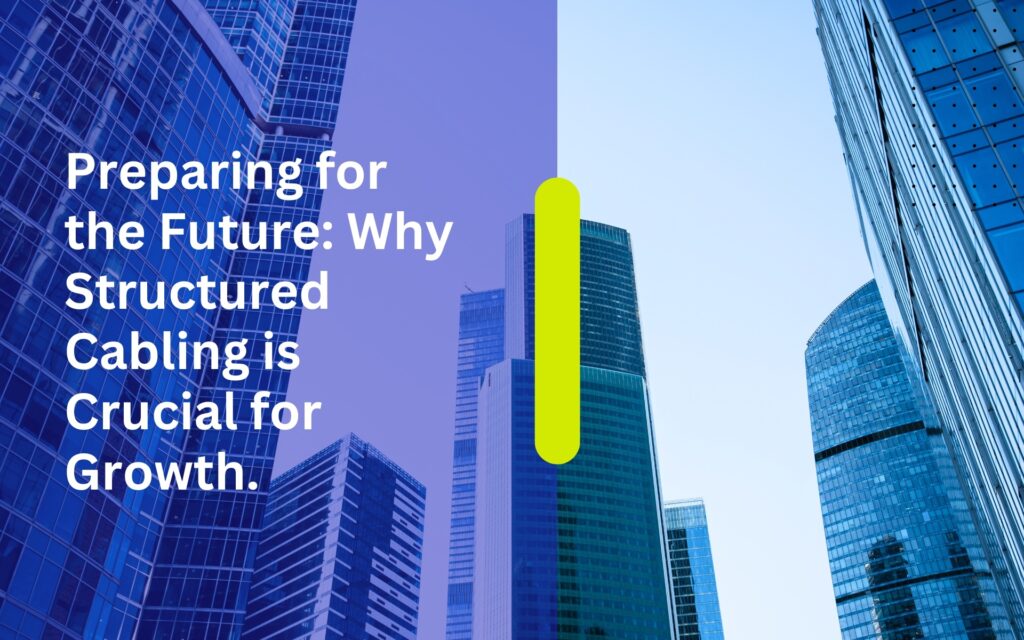Celebrating a Year of Growth and Success at InstallersPH IT Solutions. Introduction. As the year comes to a close, InstallersPH IT Solutions takes a moment to reflect on a journey defined by …
Preparing for the Future: Why Structured Cabling is Crucial for Growth.

Introduction
In today’s fast-paced digital landscape, where technological advancements occur at breakneck speed, businesses find themselves in a perpetual race to stay ahead of the curve and maintain their competitive edge. As companies strive to adapt to changing market dynamics and meet the evolving needs of their customers, the significance of a robust and efficient IT infrastructure becomes increasingly apparent. Yet, amidst the buzz of emerging technologies and innovative solutions, one foundational element often remains overlooked: structured cabling.
Structured cabling serves as the backbone of modern IT infrastructure, providing the framework upon which all digital communications and data transmission rely. While it may not always occupy the spotlight like flashy software or cutting-edge hardware, its role is indispensable. Imagine a skyscraper without a solid foundation; similarly, without a well-designed cabling infrastructure, businesses risk instability, inefficiency, and limited scalability.
The digital age has ushered in an era of unprecedented connectivity and data dependency. From cloud computing and big data analytics to IoT devices and remote collaboration tools, businesses are increasingly reliant on their IT infrastructure to power their operations and drive growth. Structured cabling forms the bedrock of this infrastructure, facilitating seamless communication and data exchange across networks, servers, and devices.
Unlike ad-hoc cabling setups that may be hastily implemented to address immediate needs, structured cabling takes a comprehensive and strategic approach to network design. It involves carefully planning and organizing cables, connectors, and related hardware to create a cohesive and standardized framework. This approach not only ensures reliability and performance but also lays the groundwork for future expansion and upgrades.
Structured cabling is akin to the nervous system of a business, enabling the smooth flow of information and ensuring that every component of the IT ecosystem functions harmoniously. Whether it’s transmitting mission-critical data between servers, facilitating VoIP calls between employees, or supporting high-speed internet access for customers, structured cabling is the invisible force that keeps operations running seamlessly.
Moreover, structured cabling is not merely a short-term solution; it is an investment in long-term sustainability and growth. As businesses evolve and expand, their IT infrastructure must adapt accordingly. Structured cabling provides the flexibility and scalability needed to accommodate these changes without costly and disruptive overhauls. Whether adding new workstations, integrating multimedia systems, or expanding into new office spaces, businesses can scale their cabling infrastructure with minimal hassle and expense.
Furthermore, the benefits of structured cabling extend beyond performance and scalability; they also encompass reliability, security, and compliance. A well-organized cabling system minimizes the risk of cable failures, signal interference, and downtime, thereby enhancing overall reliability and uptime. Additionally, structured cabling promotes cybersecurity by implementing best practices for cable management, access control, and data encryption. Compliance with industry regulations and standards is also easier to achieve with a structured cabling system, as it provides a framework for documenting and maintaining compliance-related documentation.
In essence, structured cabling is the unsung hero of modern business infrastructure, quietly but indispensably supporting growth, innovation, and sustainability. By investing in a robust and scalable cabling infrastructure, businesses can future-proof their operations, optimize performance, and position themselves for success in an ever-evolving digital landscape.
1. Foundation for Expansion
At the core of any thriving enterprise lies the inherent need for adaptability and growth. In today’s rapidly evolving business landscape, characterized by technological innovation and shifting market dynamics, the ability to scale operations and embrace change is essential for long-term success. As companies expand their reach, diversify their offerings, and respond to emerging opportunities, the demands on their IT infrastructure multiply exponentially. Without a sturdy foundation in place, the process of scaling up can quickly spiral into a logistical nightmare, riddled with inefficiencies, bottlenecks, and unforeseen obstacles.
Structured cabling serves as the bedrock of a resilient and future-ready IT infrastructure, providing a cohesive framework that can easily accommodate the evolving needs of businesses. Unlike ad-hoc cabling solutions that may suffice in the short term but quickly unravel as the network grows, structured cabling offers a strategic approach to network design, organization, and management. By meticulously planning the layout, routing, and connectivity of cables, businesses can create a scalable infrastructure that is agile, efficient, and adaptable to change.
One of the key advantages of structured cabling lies in its inherent flexibility and scalability. Whether it’s expanding into new markets, adding new departments, or integrating innovative technologies, businesses need an infrastructure that can grow with them. Structured cabling provides the flexibility to add new devices, upgrade equipment, and expand network capacity without the need for costly and disruptive retrofits. By standardizing cable types, connectors, and configurations, businesses can seamlessly integrate new components into their existing infrastructure, minimizing downtime and optimizing performance.
2. Enhanced Reliability and Performance
In today’s hyper-connected world, where business transactions occur at the speed of light and customer expectations for uninterrupted service are at an all-time high, downtime is simply not an option. Every minute of network disruption can have far-reaching consequences, leading to lost productivity, revenue, and eroded customer trust. Structured cabling emerges as a crucial solution in mitigating the risk of downtime by providing a reliable and resilient infrastructure designed to withstand the relentless demands of modern business operations.
Structured cabling goes beyond mere connectivity; it serves as the backbone of a business’s digital nervous system, ensuring seamless communication and data exchange across the organization. By adhering to industry best practices and standards, structured cabling minimizes the risk of cable failures, signal degradation, and other common issues that can disrupt network operations. This proactive approach to infrastructure management not only enhances reliability but also fosters a culture of dependability and trust among employees and customers alike.
Moreover, structured cabling plays a pivotal role in optimizing network performance, thereby enhancing the overall user experience for both internal stakeholders and external clients. By reducing latency, improving data transfer speeds, and minimizing packet loss, structured cabling enables businesses to deliver faster, more responsive services that meet the expectations of today’s digitally savvy consumers. Whether it’s accessing critical business applications, streaming high-definition multimedia content, or conducting real-time video conferencing, a well-designed structured cabling system ensures that data flows seamlessly, without bottlenecks or interruptions.
3. Simplified Maintenance and Troubleshooting
In a complex IT environment characterized by a myriad of interconnected systems and devices, troubleshooting network issues can quickly become a daunting and time-consuming task. Without a structured cabling system in place to provide a roadmap for managing network infrastructure, IT teams may find themselves grappling with a tangled web of cables and connections akin to searching for a needle in a haystack. Structured cabling emerges as a beacon of clarity amidst this chaos, simplifying maintenance and troubleshooting through its organized and systematic approach.
Structured cabling transforms the labyrinthine network landscape into a well-defined and easily navigable terrain by virtue of its clear and organized framework. With cables meticulously labeled, connectors standardized, and a logical layout established, IT teams gain unprecedented visibility into the network architecture, enabling them to swiftly pinpoint issues and trace connections. Whether troubleshooting a connectivity issue, diagnosing a performance bottleneck, or addressing a security vulnerability, structured cabling provides the foundational groundwork for effective problem resolution.
Moreover, structured cabling serves as a bulwark against the risk of human error, ensuring that networks remain secure and reliable at all times. By minimizing the potential for misconfigurations, cable mismatches, and other common pitfalls, structured cabling enhances the integrity and resilience of the network infrastructure. This not only reduces the likelihood of service disruptions and downtime but also bolsters data security and compliance efforts, safeguarding sensitive information from unauthorized access or breaches.
4. Support for Emerging Technologies
As technology continues its relentless march forward, businesses find themselves in a perpetual quest for innovation and competitive advantage. The landscape is teeming with possibilities, from the transformative potential of cloud computing and virtualization to the revolutionary promise of IoT devices and AI-powered analytics. Yet, amidst this cornucopia of opportunities, one fundamental truth remains: the successful implementation of these emerging technologies hinges upon the presence of a robust and adaptable IT infrastructure.
Structured cabling emerges as the unsung hero in this narrative, providing the backbone upon which these technological marvels can thrive. Unlike traditional cabling setups that may struggle to keep pace with the demands of modern technology, structured cabling offers the flexibility and bandwidth needed to support the latest advancements. Whether it’s the deployment of high-speed Ethernet connections to facilitate lightning-fast data transfers or the integration of power-over-Ethernet devices to streamline power delivery and reduce cable clutter, structured cabling lays the groundwork for a seamless transition to the digital future.
Furthermore, structured cabling empowers businesses to embrace innovation with confidence, knowing that their infrastructure can adapt and evolve in lockstep with emerging technologies. By future-proofing their IT infrastructure, businesses can position themselves as agile and responsive players in an ever-changing marketplace. Whether it’s anticipating the proliferation of IoT devices in the workplace, preparing for the advent of 5G connectivity, or exploring the potential of edge computing to drive real-time insights, structured cabling provides the foundation upon which these innovations can flourish.
5. Cost-Effective Scalability
In today’s business environment, where every expenditure is scrutinized for its potential impact on the bottom line, cost-effectiveness reigns supreme. Each investment must not only deliver tangible value but also contribute to the organization’s overall profitability and competitiveness. Structured cabling emerges as a beacon of cost-effectiveness in this landscape, offering a strategic solution for scaling IT infrastructure without incurring exorbitant expenses.
Structured cabling’s cost-effectiveness begins with its ability to streamline and consolidate cabling infrastructure, minimizing the need for excessive cable runs and redundant components. By centralizing and organizing cables within a structured framework, businesses can optimize space utilization and reduce material costs associated with cable installation. Moreover, the standardized nature of structured cabling components allows for greater economies of scale, further driving down procurement costs and ensuring consistent quality across installations.
Additionally, structured cabling helps businesses reduce ongoing maintenance costs by simplifying cable management and minimizing the risk of cable-related issues. With clearly labeled cables, standardized connectors, and a logical layout, IT teams can quickly identify and address maintenance needs, reducing the time and resources required for routine upkeep. This proactive approach not only minimizes the risk of unexpected downtime but also extends the lifespan of cabling infrastructure, maximizing the return on investment over the long term.
Furthermore, the modular nature of structured cabling offers inherent cost savings by allowing businesses to scale their infrastructure incrementally, as needed. Rather than investing in a large-scale overhaul to accommodate future growth, businesses can add or remove components as demand dictates, ensuring that they only pay for the resources they require, when they need them. This flexibility not only minimizes upfront capital expenditures but also allows businesses to align their infrastructure investments with their evolving needs and budgetary constraints.
6. Compliance and Future-Proofing
In an era of heightened regulatory scrutiny and evolving cybersecurity threats, compliance has become a non-negotiable imperative for businesses across industries. From stringent data privacy laws such as GDPR and CCPA to industry-specific regulations like HIPAA and PCI DSS, organizations face a complex web of requirements aimed at safeguarding sensitive information and mitigating risk. Structured cabling emerges as a critical tool in the compliance arsenal, offering a secure and standardized infrastructure that aligns with industry best practices and regulatory mandates.
Structured cabling serves as the foundation upon which businesses can build a compliant and resilient IT infrastructure. By adhering to established standards for cable management, labeling, and documentation, businesses can ensure that their cabling infrastructure meets the rigorous requirements of regulatory frameworks and industry guidelines. From physical security measures to data encryption protocols, structured cabling provides the framework necessary to address key compliance concerns and demonstrate adherence to regulatory mandates.
Moreover, structured cabling enables businesses to future-proof their IT infrastructure against the evolving landscape of compliance standards and cybersecurity threats. By investing in a robust and adaptable cabling infrastructure, businesses can anticipate and address emerging compliance requirements before they become mandates. Whether it’s implementing enhanced data encryption protocols, enhancing access controls, or implementing audit trails for monitoring and reporting purposes, structured cabling provides the flexibility and scalability needed to stay ahead of regulatory trends and ensure ongoing compliance.
Conclusion
In conclusion, structured cabling is not just a necessity for businesses; it’s a strategic investment in the future. By providing a scalable, reliable, and cost-effective foundation for IT infrastructure, structured cabling enables businesses to adapt and grow in the face of technological change. From supporting expansion and enhancing reliability to simplifying maintenance and enabling innovation, structured cabling plays a crucial role in driving business growth and success in the digital age. As businesses continue to embrace new technologies and navigate an increasingly complex IT landscape, structured cabling will remain a cornerstone of their strategy for achieving long-term sustainability and competitiveness.
Related Articles
Notice to the Public: Holiday Vacation Advisory of InstallersPH IT Solutions. Introduction. InstallersPH IT Solutions is committed to providing reliable and professional IT services to all our valued clients and partners. As …
The On-the-Job Training Experience of Sherlyn Linao. Introduction On-the-Job Training (OJT) is an essential part of a student’s academic development, providing practical exposure to real workplace environments. It allows interns to apply …



